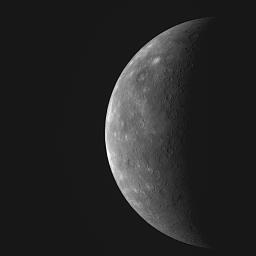MESSENGER Sees the Previously Unseen!
Caption:
Yesterday, as the spacecraft approached Mercury for the mission's third flyby of the Solar System's innermost planet, MESSENGER captured thi striking view. This WAC image shows portions of Mercury's surface that had remained unseen by spacecraft even after the three flybys by Mariner 10 in 1974-75 and MESSENGER's two earlier flybys in 2008. In this image, just returned to Earth early this morning, the newly imaged terrain is located in a wide vertical strip near the limb of the planet (on the left side of Mercury's partially sunlit disk). Viewing the
image coverage map
from before the flyby provides more information on the location of the newly seen area. This WAC image is just one of 11 taken through the camera's narrow-band color filters, and this set of images will be used to examine color differences on Mercury's surface and to learn about the evolution of crustal rocks on the planet.
Date Acquired:
September 29, 2009
Image Mission Elapsed Time (MET):
162741055
Instrument:
Wide Angle Camera (NAC) of the Mercury Dual Imaging System (MDIS)
WAC Filter:
7 (750 nanometers)
Resolution:
4.8 kilometers/pixel (3.0 miles/pixel)
Scale:
Mercury's diameter is 4880 kilometers (3030 miles)
Spacecraft Altitude:
26,900 kilometers (16,700 miles)
Background Info:
These images are from MESSENGER, a NASA Discovery mission to conduct the first orbital study of the innermost planet, Mercury. For information regarding the use of images, see the MESSENGER
image use policy
.
Cataloging Keywords:
| Name |
Value |
Additional Values |
| Target |
Mercury |
|
| System |
|
|
| Target Type |
Planet |
|
| Mission |
MESSENGER |
Mariner |
| Instrument Host |
MESSENGER |
Mariner 10 |
| Host Type |
Orbiter |
Flyby Spacecraft |
| Instrument |
Mercury Dual Imaging System (MDIS) |
|
| Detector |
Narrow Angle Camera (NAC) |
|
| Extra Keywords |
Grayscale, Map |
| Acquisition Date |
|
| Release Date |
2009-09-30 |
| Date in Caption |
2009-09-29 |
|
| Image Credit |
NASA/Johns Hopkins University Applied Physics Laboratory/Carnegie Institution of Washington |
| Source |
photojournal.jpl.nasa.gov/catalog/PIA12265 |
| Identifier |
PIA12265 |

 Planetary Data System
Planetary Data System
